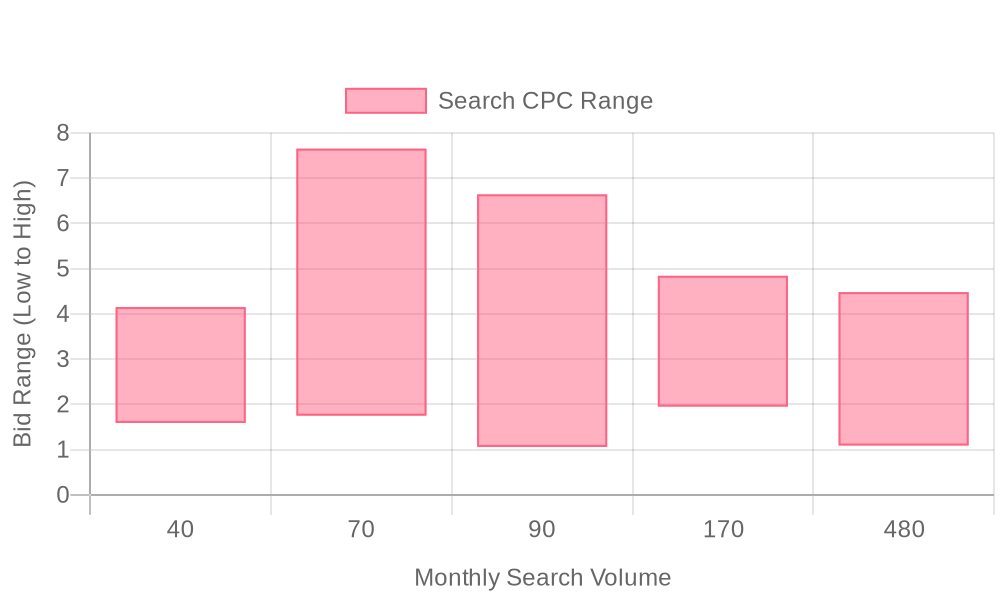
Supercharge your lead generation with a FREE Google Ads audit - no strings attached! See how you can generate more and higher quality leads
Get My Free Google Ads AuditFree consultation

No commitment
Supercharge your lead generation with a FREE LinkedIn Ads audit - no strings attached! See how you can generate more and higher quality leads
Get My Free Google Ads AuditFree consultation

No commitment
Supercharge your lead generation with a FREE Meta Ads audit - no strings attached! See how you can generate more and higher quality leads
Get My Free Google Ads AuditGet My Free LinkedIn Ads AuditGet My Free Meta Ads AuditFree consultation

No commitment
Supercharge your lead generation with a FREE Google Ads audit - no strings attached! See how you can generate more and higher quality leads
Get My Free Google Ads AuditFree consultation

No commitment
In today's rapidly evolving digital landscape, online publications face a unique set of challenges that hinder their growth potential. One major obstacle is missing out on high-value prospects who don't interact with direct calls-to-action—a gap that underscores the need for robust tracking systems and advanced targeting. Without visibility into these silent opportunities, publishers risk losing valuable engagement and revenue. Leveraging the power of Google Ads can bridge this gap, by driving traffic, increasing visibility, and enhancing revenue streams through strategic audience insights and adaptive targeting. For digital publishers, effectively utilizing Google Ads means not only reaching potential readers and advertisers at the right moment but also understanding their interactions to optimize campaign execution. However, setting up high-performing Google Ads campaigns necessitates an in-depth insight into audience behavior and intent, coupled with precise, technical execution for impactful results.

Online publications face unique challenges in capturing high-quality leads, given the crowded digital landscape and the rapid pace at which audiences consume content. A data-driven approach to lead generation provides the clarity needed to distinguish between casual visitors and those most likely to become engaged subscribers or advertising prospects.
Precision in keyword and audience targeting is essential for online magazines, digital publications, and content creators. By focusing on intent signals and content consumption patterns, marketing teams can direct budget toward segments with the highest conversion potential, minimizing wasted spend on disengaged audiences.

Online publications face a dynamic landscape where audience attention is fragmented and direct conversions can be elusive. Leveraging Google Ads allows publishers to efficiently capture targeted audiences using advanced targeting features while ensuring campaigns reach visitors who demonstrate clear intent or interest.
With specialized targeting, digital publications can pinpoint high-value reader segments and address gaps left by traditional channels like email and social media. These platforms often lack the immediacy or follow-up precision required to re-engage visitors who showed initial interest but did not convert, whereas Google Ads supports real-time engagement and retargeting opportunities. To enhance precision, publishers can use Sona’s Audiences tool that auto-syncs with ad platforms for hyper-personalized targeting.
Tailored messaging within ad campaigns enables publishers to connect with segments most likely to become loyal subscribers or customers, optimizing both engagement and lead quality. By dynamically updating audiences as leads move through the funnel, marketers can refine their approach and allocate budgets based on real-time behavioral signals, increasing the likelihood of converting high-intent visitors.
Robust analytics and measurement tools offer transparency into which ads and audience segments drive the highest conversions. Integrating unified visitor identification and advanced conversion tracking—including online and offline attribution—empowers revenue teams to accurately measure ROI, adjust strategies, and synchronize qualified leads into connected platforms for seamless follow-up and nurture. This holistic approach transforms Google Ads for online publications from a simple acquisition channel into a core engine for audience growth, content monetization, and long-term revenue optimization. To explore how you can leverage these features, get started for free with Sona.


Online publications face a dynamic landscape where attention is fragmented and audience loyalty is influenced by both content quality and discoverability. To drive growth, revenue teams need precise, actionable strategies rooted in data and tailored to the unique behaviors of digital readers.
Each of these strategies is enhanced by leveraging unified go-to-market data, allowing marketing teams to identify growth pockets, adapt to audience shifts, and deliver personalized engagement that translates into measurable results. This approach not only strengthens content visibility but also maximizes the impact of every marketing dollar spent across content monetization and broader digital media campaigns. Ready to see the impact? Get started for free with Sona.

Audience segmentation is fundamental for online publications aiming to maximize the impact of Google Ads campaigns. By distinguishing between loyal readers and new visitors, publishers can create campaign strategies that speak directly to each group’s unique behaviors and motivations, resulting in higher engagement and improved return on ad spend.
When defining audience segments, marketers should leverage both explicit and behavioral data. Loyal subscribers typically respond to tailored content and personalized offers, while first-time visitors may require more educational or introductory messaging. Using intent signals such as visit frequency, content consumption patterns, and time-on-site allows for more granular segmentation. These insights help prevent missed upsell or cross-sell opportunities, ensuring each campaign message is relevant and timely.
For effective audience segmentation, ad groups must align tightly with the specific needs of each segment. Building ad groups around precise audience intelligence addresses the risk of disconnected messaging and improves campaign coherence. This alignment allows teams to serve creative assets that resonate with the unique interests of each group, whether the goal is promoting premium subscriptions to engaged readers or introducing editorial highlights to new visitors.
Seamless tracking from click to conversion is essential for understanding the complete customer journey within Google Ads for Online Publications. Integrating advanced attribution tools enables publishers to map every interaction, from initial ad engagement to final conversion, both online and offline. Solutions that unify CRM and website data with Google Ads provide a holistic view of performance, allowing for dynamic audience updates as leads progress through the funnel. This integration empowers revenue teams to optimize spend, refine targeting strategies, and consistently drive higher-value conversions through actionable insight into every segment’s behavior. Looking to apply these strategies in your campaigns? Get started for free with Sona.

| Industry | Keyword | Monthly Search Volume | Competition Level | Low Bid | High Bid |
| Online Publications | paper publishing websites | 40 | LOW | 1.59 | 4.15 |
| Online Publications | scholarly journals online free | 70 | LOW | 1.75 | 7.65 |
| Online Publications | journal articles for free | 90 | LOW | 1.06 | 6.64 |
| Online Publications | online publications | 170 | LOW | 1.95 | 4.84 |
| Online Publications | peer reviewed articles free | 480 | LOW | 1.09 | 4.48 |
High-intent keyword targeting is critical for online publications aiming to attract decision-makers and buyers ready to engage with premium content, subscription offers, or B2B advertising opportunities. Focusing on search phrases that reflect clear purchase or partnership motivation allows publications to bypass the inefficiency of broad, generic outreach and instead capture a higher-value audience segment.
By prioritizing niche and long-tail keywords, online publications can drive more efficient ad spend and achieve stronger ROI from Google Ads platform. For example, keywords like “advertising in financial digital magazines,” “B2B technology publication sponsorships,” or “submit press releases to online trade journals” are tailored to users with immediate needs that align closely with the publication’s value proposition. This approach surfaces leads already primed for conversion, improving both click-through and post-click engagement rates.
Unified go-to-market platforms empower publishers to surface granular keyword opportunities by analyzing visitor intent signals across search, content engagement, and CRM data. Marketers can identify not only which terms drive traffic but also which keywords correlate with high-value actions, such as newsletter sign-ups, demo requests, or ad inquiries. When audience and conversion data sync seamlessly into Google Ads, campaign managers can continuously refine targeting based on real market demand, maximizing every dollar spent on acquisition and monetization.
For example, real-time visitor identification enables teams to build exclusion or retargeting lists that adapt dynamically as users move from anonymous browsing to registered users or paying advertisers. This ensures ongoing keyword optimization and message alignment, driving greater relevance and improved campaign outcomes for digital publications. To experience the benefits firsthand, get started for free with Sona.
Precision in keyword selection is fundamental for online publications seeking to maximize the impact of Google Ads. By organizing keywords into topic clusters and layering on search intent modifiers, teams can ensure campaigns reach audiences actively searching for specific content themes and niche interests. This approach surfaces high-value prospects who might be missed by broad, generic keyword strategies common in digital publishing. For a comprehensive overview of the Google Ads platform and campaign management options, review the Google Ads platform.
Negative keywords are essential for optimizing ad spend. Excluding irrelevant queries prevents ads from being displayed to users unlikely to convert, which preserves budget and elevates campaign efficiency. When integrated with platforms that identify visitors and sync audience insights directly into Google Ads for online media, teams can refine their targeting even further, ensuring only the most relevant traffic sees their offers.
High-performing ad copy for digital publications must address well-researched pain points and offer relevant incentives, especially for audiences who read feature-driven articles but rarely take action. Crafting messages that echo the language of the publication’s audience increases relevance and engagement. Incorporating dynamic ad extensions—such as sitelinks, callouts, or structured snippets—ensures calls-to-action stand out and are quickly actionable. For more advice on messaging and campaign optimization, browse the Sona blog.
A deeper layer of optimization is possible when real-time intent signals are analyzed to shape messaging and creative. When ad platforms are connected with systems that update audience segments as readers move from passive browsing to active inquiry, campaigns can deliver tailored content and offers at precisely the right moment, increasing the likelihood of meaningful engagement.
Landing pages should maintain a seamless narrative from the ad, guiding users through a focused, distraction-free conversion journey. For online magazines and digital publications, this means aligning page messaging and visuals with the ad’s promise, ensuring the transition feels natural and expectations are met. Reducing unnecessary navigation options and employing clear, visually compelling calls-to-action helps retain visitor attention and drive desired outcomes. Explore a step-by-step explanation of Google Ads to better understand how user journeys can be optimized from ad to landing page.
Engagement rates improve when landing pages are dynamically constructed based on visitor profile and interest data. By leveraging solutions that recognize returning companies or high-intent readers, publications can serve bespoke content offers or subscription prompts, increasing the probability of conversion for segments most likely to provide long-term value.
Continuous campaign refinement hinges on leveraging advanced bidding strategies and systematic A/B testing. For online publications, algorithms can automatically adjust bids to prioritize placements that yield higher engagement and conversions, optimizing for business objectives in real time. Regular creative and targeting tests reveal what elements resonate best, informing future iterations. Learn more about measuring marketing’s influence on the sales pipeline.
Importing offline conversions—such as newsletter sign-ups or event registrations—into the analysis platform provides a more complete view of campaign effectiveness. This holistic approach enables revenue teams to adjust strategies based on both online and offline engagement, increasing confidence in reported ROI. When audience, lead, and conversion data sync seamlessly with CRM and ad platforms, every interaction informs smarter media allocation and campaign optimization, closing the loop between marketing investment and tangible outcomes. To see how these optimizations can drive results for your publication, get started for free with Sona.
Online publications can accelerate growth by leveraging segmented audience insights to tailor upsell opportunities and premium content delivery. Analyzing visitor behavior reveals patterns that enable targeted messaging, turning casual readers into engaged subscribers and driving higher lifetime value—discover more approaches in our marketing attribution blog.
Strategic partnerships with industry leaders help publishers overcome the fragmentation of marketing efforts, providing a unified approach for campaign execution across diverse platforms. This synchronization ensures consistent messaging and eliminates resource overlap, creating a stronger brand presence in a competitive digital landscape—follow practical strategies in our pipeline performance playbooks.
Geographic targeting unlocks new audience segments by pinpointing variations in engagement across regions, allowing for hyper-localized campaigns that resonate with readers’ unique interests. By optimizing content and ads for high-performing geographies, publications can maximize reach while reducing wasted spend on less relevant audiences—see how audience data syncs to platforms for seamless activation.
Search query insights empower dynamic content creation by surfacing trending questions and emerging interests within your readership. Adapting editorial calendars based on real-time search behavior not only boosts SEO performance but also transforms passive leads into active participants, as content aligns with audience intent and immediate needs. For more guidance on leveraging intent signals, visit our intent data guide.
Harnessing the full potential of Google Ads means integrating advanced identification and intent data to capture high-converting traffic. When platforms sync enriched audience data into Google Ads, editorial and sales teams gain the ability to retarget engaged users, attribute conversions accurately, and measure ROI across both online and offline interactions. If you’re ready to take the next step, get started for free with Sona and unlock smarter campaign execution for your publication.
Harnessing the power of Google Ads can transform the landscape for online publications, offering a strategic pathway to reach and engage target audiences effectively. As we've explored, the key lies in understanding the unique challenges of digital advertising and implementing targeted strategies that enhance visibility and drive revenue growth.
Through a deep dive into the intricacies of Google Ads, we've addressed the critical need for precise audience targeting, effective ad placement, and the importance of data-driven decisions. By aligning these strategies with your publication's goals, you can optimize your ad spend and maximize return on investment, leading to sustainable growth in a competitive digital environment.
Imagine the possibilities when your online publication not only reaches the right audience but also converts these engagements into meaningful interactions. Embracing these strategies can lead to enhanced visibility, increased readership, and ultimately, a thriving digital presence. By taking actionable steps, you set the stage for a successful advertising journey that aligns with your publication's vision.
Ready to elevate your advertising strategy? Start for free to explore our platform's capabilities and unlock the potential of your online publication today.
Google Ads can be used to promote online publications by driving traffic, increasing visibility, and enhancing revenue streams through strategic audience insights and adaptive targeting.
Best practices include precision in keyword and audience targeting, aligning landing pages and ad creative, and continuous performance optimization using advanced attribution models.
Google Ads can increase readership by capturing targeted audiences using advanced targeting features and retargeting opportunities to engage high-value prospects.
Costs involve ad spend which can be optimized by targeting high-intent keywords and audience segments to reduce waste on disengaged audiences.
Effectiveness can be tracked using robust analytics, conversion tracking, and advanced attribution models that measure ROI and inform strategy adjustments.
Effective ad types include search campaigns for capturing high-intent readers, display ads for brand awareness, video ads for storytelling, and remarketing to re-engage visitors.
Optimize budget by focusing on high-conversion audience segments, refining keyword strategy, and leveraging data-driven optimizations and real-time intent signals.
Useful features include advanced targeting, audience segmentation, and ad extensions that enhance visibility and engagement with high-value action pathways.
The process involves building targeted keyword lists, developing compelling ad copy, designing effective landing pages, and implementing data-driven optimizations.
Target specific audiences by using enriched CRM data, intent signals, and dynamic audience syncing to ensure campaigns reach the most relevant segments.
Join results-focused teams combining Sona Platform automation with advanced Google Ads strategies to scale lead generation

Connect your existing CRM

Free Account Enrichment

No setup fees
No commitment required

Free consultation

Get a custom Google Ads roadmap for your business
Join results-focused teams combining Sona Platform automation with advanced Meta Ads strategies to scale lead generation

Connect your existing CRM

Free Account Enrichment

No setup fees
No commitment required

Free consultation

Get a custom Google Ads roadmap for your business
Join results-focused teams combining Sona Platform automation with advanced LinkedIn Ads strategies to scale lead generation

Connect your existing CRM

Free Account Enrichment

No setup fees
No commitment required

Free consultation

Get a custom Google Ads roadmap for your business
Join results-focused teams using Sona Platform automation to activate unified sales and marketing data, maximize ROI on marketing investments, and drive measurable growth

Connect your existing CRM

Free Account Enrichment

No setup fees
No commitment required

Free consultation

Get a custom Google Ads roadmap for your business
Over 500+ auto detailing businesses trust our platform to grow their revenue
Join results-focused teams using Sona Platform automation to activate unified sales and marketing data, maximize ROI on marketing investments, and drive measurable growth

Connect your existing CRM

Free Account Enrichment

No setup fees
No commitment required

Free consultation

Get a custom Google Ads roadmap for your business
Over 500+ auto detailing businesses trust our platform to grow their revenue
Join results-focused teams using Sona Platform automation to activate unified sales and marketing data, maximize ROI on marketing investments, and drive measurable growth

Connect your existing CRM

Free Account Enrichment

No setup fees
No commitment required

Free consultation

Get a custom Google Ads roadmap for your business
Over 500+ auto detailing businesses trust our platform to grow their revenue
Our team of experts can implement your Google Ads campaigns, then show you how Sona helps you manage exceptional campaign performance and sales.
Schedule your FREE 15-minute strategy sessionOur team of experts can implement your Meta Ads campaigns, then show you how Sona helps you manage exceptional campaign performance and sales.
Schedule your FREE 15-minute strategy sessionOur team of experts can implement your LinkedIn Ads campaigns, then show you how Sona helps you manage exceptional campaign performance and sales.
Schedule your FREE 15-minute strategy sessionOur team of experts can help improve your demand generation strategy, and can show you how advanced attribution and data activation can help you realize more opportunities and improve sales performance.
Schedule your FREE 30-minute strategy sessionOur team of experts can help improve your demand generation strategy, and can show you how advanced attribution and data activation can help you realize more opportunities and improve sales performance.
Schedule your FREE 30-minute strategy sessionOur team of experts can help improve your demand generation strategy, and can show you how advanced attribution and data activation can help you realize more opportunities and improve sales performance.
Schedule your FREE 30-minute strategy sessionOur team of experts can help improve your demand generation strategy, and can show you how advanced attribution and data activation can help you realize more opportunities and improve sales performance.
Schedule your FREE 30-minute strategy session





Launch campaigns that generate qualified leads in 30 days or less.
